Vegan Miso Ramen Japanese Soup
This Vegan Miso Ramen Japanese Soup is flavored with miso broth and a mix of vegetables like cabbage, green onions, and corn served over a bed of delicious ramen noodles. It is hearty enough to be a complete meal all by itself and it happens to be plant-based, vegetarian, and vegan.
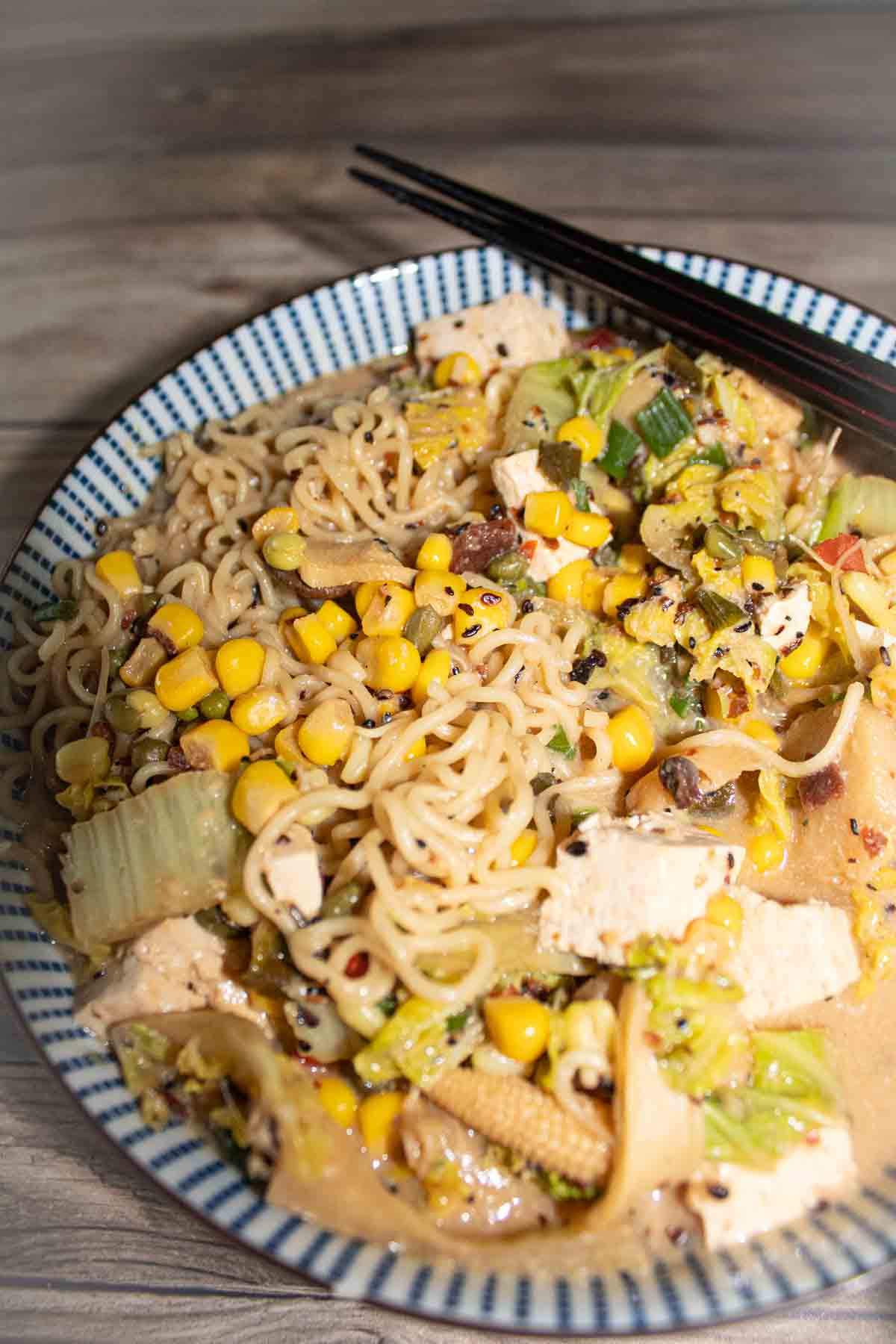
My sister lived in Japan back in the late 80s and early 90s, and she learned to make some delicious Asian food while she was there. This miso ramen soup recipe is one of her favorites, and I love that she agreed to share her fabulous recipe with us here. If you’re looking for a simple recipe that can be ready in 10 minutes, try our easy vegan ramen noodles!
She recently became a recipe developer for this website. Some of the other recipes she has shared so far include easy veggie sushi and dashi Japanese soup broth which is used in this recipe. Check out our list of vegan Asian recipes for even more inspiration.
What is miso ramen?
Miso ramen soup is a beautiful Japanese soup made with ramen noodles and vegetables in a thick, rich miso paste soup base. It has a salty and creamy umami flavor and texture.
Much more than a simple soup, miso ramen is a robust, hearty bowl of yumminess that is a complete meal in itself. Loaded with noodles, tofu, and veggies, it is high in protein and fiber that will keep you full for hours. This soup is delicious when served with Asian dumplings.
Reasons you will love this recipe
- Healthy and Oil-Free: This vegan miso ramen is made without any added oils, making it a lighter and healthier choice for a nourishing meal.
- Rich, Umami Flavor: Enjoy a deep, savory taste from the miso and vegetable broth, offering a comforting bowl of ramen that’s full of flavor.
- Packed with Plant-Based Goodness: Loaded with fresh vegetables and wholesome ingredients, this ramen provides essential nutrients and vitamins.
Ingredients you will need
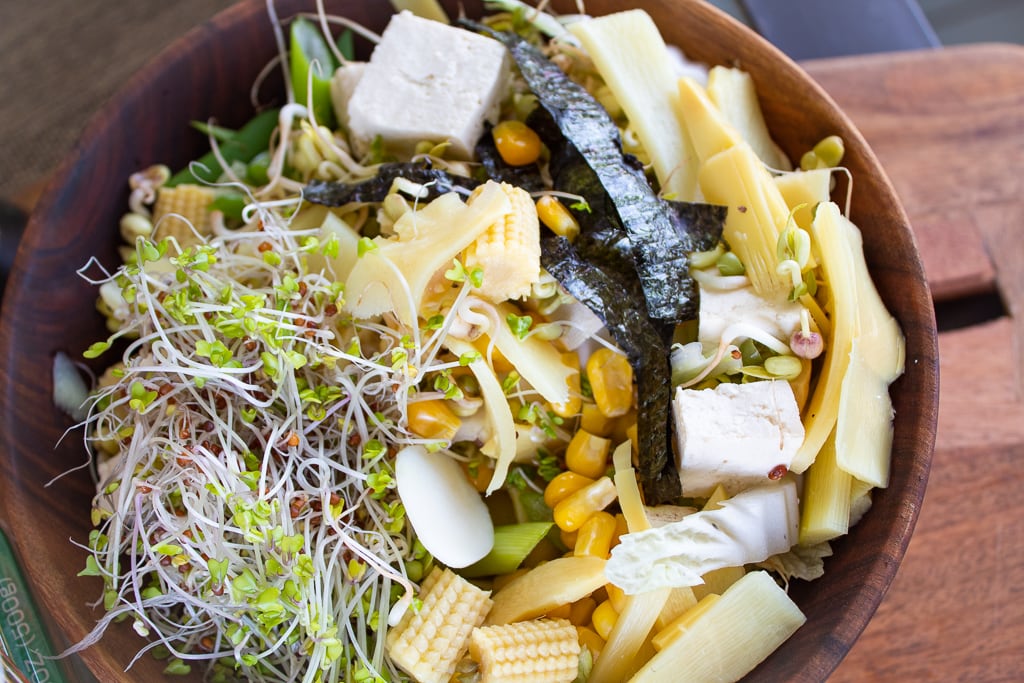
- Miso- This can be found in the refrigerated section of many grocery stores as well as natural food stores and Asian markets. It is commonly called soybean paste and has a mellow, slightly sweet flavor.
- Bean paste- Doubanjiang bean paste is a combination of fermented beans and chilis and it is the secret ingredient to this ramen recipe. It is the ingredient that enhances the savory umami flavor in the soup broth.
- Seasonings- A couple of important seasonings are soy sauce and sake. If you aren’t familiar with cooking with sake, see the section below where I go into more detail about it.
- Sesame seeds- You don’t have to use white and black sesame seeds, but they do offer two different flavors so if you have them on hand, it definitely adds to the complexity of the broth.
- Dashi Japanese soup broth- This is a key ingredient in many Japanese recipes, soups, and sauces, and you can easily make dashi broth at home using only 2 ingredients plus water.
- Noodles- We don’t easily find fresh ramen noodles where we live, on the East Coast, but most Asian grocers carry them in both frozen and dried aisles.
- Vegetables- Use veggies like bean sprouts, napa cabbage, bamboo, and baby corn.
- Nori- These seaweed sheets are usually available in the Asian aisle of many grocery stores.
- White pepper- This is a key ingredient and it’s wonderful in soups and on fried rice.
Why do you use sake?
Sake is a Japanese alcoholic beverage made from fermented rice. A lot of traditional Japanese soup broths include a combination of soy sauce and sake because they blend together and create an almost magical complexity to the broth.
Some people may prefer not to use sake and since this soup has so much flavor, it could probably be left out without any problem.
How to make vegan miso ramen
The recipe card at the bottom of the page has the full list of ingredients with measurements and instructions.
This is not a difficult soup to make, so don’t be intimidated by the length of the instructions. We’re just trying to be thorough so you’ll be sure to have an awesome soup outcome.
Step #1: Prep Work- To begin, you will need to wash, drain, and slice all of the vegetables so they will be ready to add as soon as the soup base is ready.
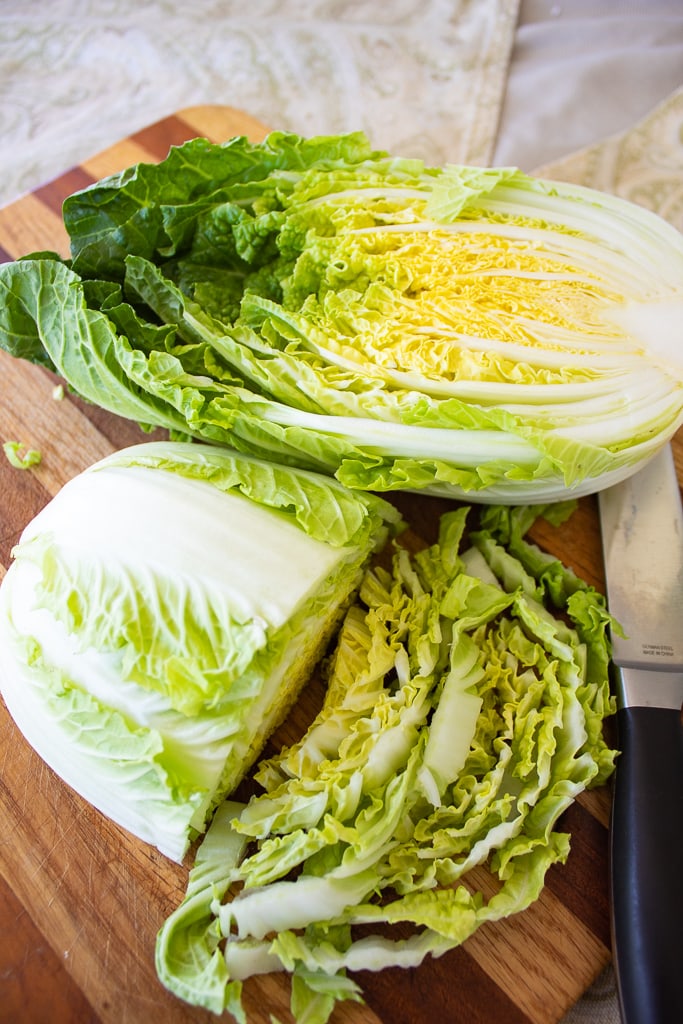
If you’re using a new (full head) napa cabbage, instead of slicing the strips horizontally from top to bottom, first slice it long-wise, splitting it straight down the middle. This way you will have two complete halves, one for now and one for your next meal.
The texture of napa cabbage changes from leafy near the top to crunchy as you work your way down. This way you can choose the select the sections you want to use in your ramen. I prefer the crunchy textures in mine! I took a photo so you can see what I mean.
Toppings: You could even prepare your toppings (veggies and tofu) a day ahead and store them in a covered container until you are ready for them. These are some of my favorite topping suggestions.
- Tofu, diced into small squares
- Napa Bok Choy, sliced into thin strips
- Bean Sprouts (any kind, but I like to use mung bean and broccoli sprouts)
- Corn (baby or sweet kernel corn or both)
- Bamboo slices
- Water chestnuts, sliced
- Green onion/scallions
- Nori, a sheet cut into strips
- White pepper powder, sprinkled lightly on top of the soup
Sesame seeds: Toast the sesame seeds by placing them in a dry frying pan and heating them on medium-high heat for just a few minutes. They will begin to turn a golden brown and start popping up out of the pan. Do not leave the pan unattended because it will burn quickly. Once the seeds are lightly browned, remove them from the heat and pour them into a small bowl, and set them to the side.
You don’t have to use white and black sesame seeds, but they do offer two different flavors so if you have them on hand, it definitely adds to the complexity of the broth. Toast them together, and I like to grind mine.
This is the grinder I use, and you can store your seeds in it as well. I keep a mixture of both kinds of seeds in mine. You can also use a coffee grinder. If you don’t have a grinder or mortar & pestle.
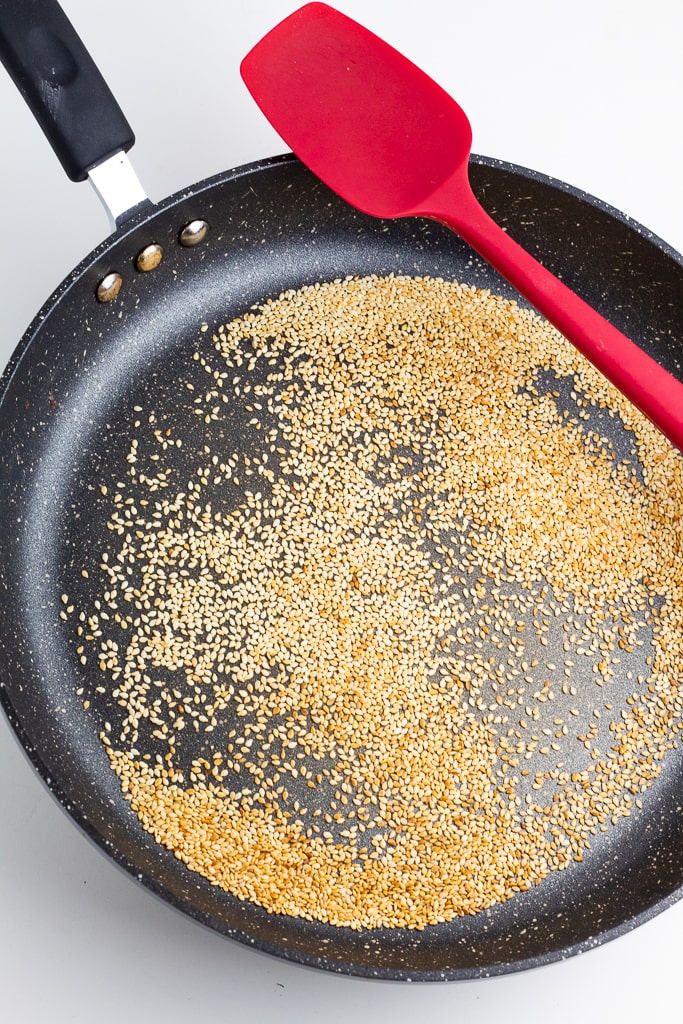
Noodles: At this point, you will also want to set out everything needed for the ramen noodles as well (but don’t cook them yet). This will include having a stockpot filled with water and heating on the stovetop, a package of noodles, and 1 tablespoon of baking soda.
Even though cooking the noodles is the last step of this soup, I keep my stockpot with the water and baking soda in it ready and heating on the stove while I work on my soup base so that I can get the noodles started easily.
Step #2: Soup Base- I prepare my soup base ingredients first and have them ready to whisk in. Since this is a little like making gravy, it’s best to be able to move through quickly so that it doesn’t scorch to the bottom of the pan.
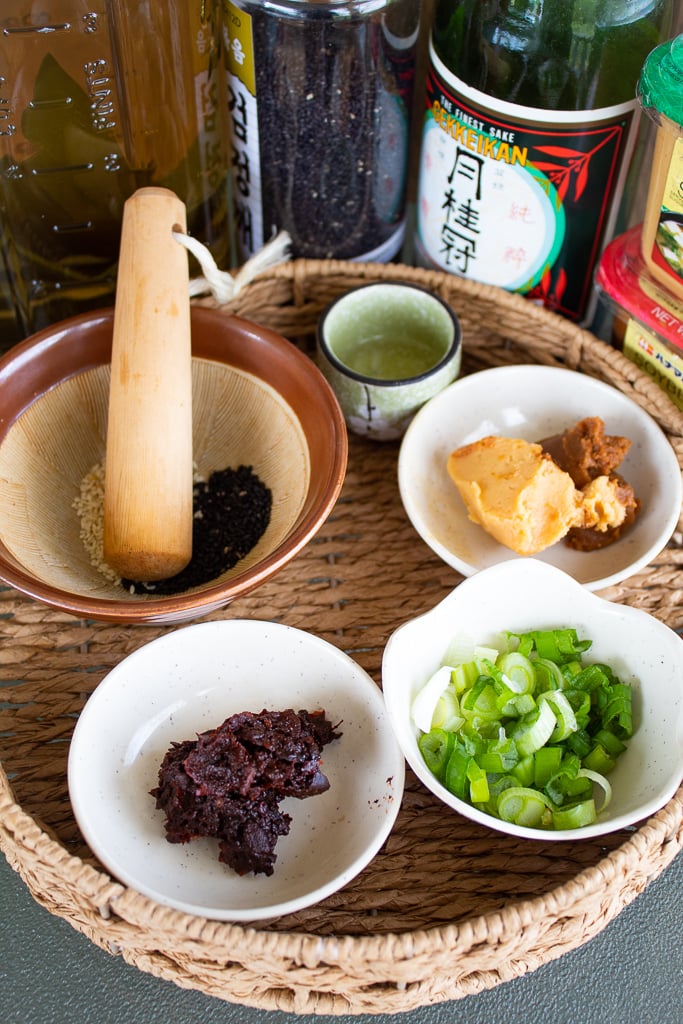
Use a 3-quart soup pot and heat about ¼ cup of the dashi broth in the bottom of the pan over medium-high heat. Mix your garlic, ginger, and half of the green onions into the dashi and cook for 1-2 minutes until fragrant.
Next, add the Doubanjiang bean paste, sugar, and miso stirring regularly with a whisk or wooden spoon to keep the mixture from sticking to the bottom of the pan. You can add more dashi if you need to keep the mixture creamy.
Add the sake, salt, sesame seeds, and soy sauce and whisk together until the mixture is smooth.
Begin adding soy milk, whisking it and gradually dissolving the other ingredients.
Slowly add the rest of the dashi broth into the mixture, continuing to blend into a creamy soup base.
Once it is piping hot and smooth, it’s time to start adding the toppings–veggies, tofu, and nori. Add the napa cabbage first and let it simmer for 1-2 minutes before adding the other toppings.
Add in the other toppings and let them simmer together for approximately 1-2 minutes, or until your veggies are the desired texture.
Remove the soup from the heat while finishing up the noodles.
Step #3: Cooking the noodles– Ramen noodles cook quickly, usually within a couple of minutes, so make sure everything else is prepared and ready to go. This is your last step, once the noodles are drained, you’ll add them to the soup base with the various toppings you’ve prepared and serve the piping hot ramen immediately.
Cook noodles according to your package instructions, usually 1 ½ to 2 minutes. Adding baking soda to ramen noodles while they are boiling gives them more of the authentic chewy texture you get in Japan. Just add the baking soda to the boiling water then add the ramen noodles.
Uncover the pot, watch carefully, and be prepared to blow or it will boil over.
Drain noodles as soon as they are done so that they don’t absorb excess moisture and become mushy. There is no need to rinse them.
Immediately divide noodles into bowls and add soup and toppings.
Helpful tips for making vegan miso ramen
- Ingredients- Visit your local Asian grocer or Amazon to find these ingredients. There is an initial upfront investment if you’re not accustomed to cooking with Asian ingredients, but we’re working to give you a variety of tasty recipes to use these same ingredients in and they store well.
- Doubanjiang bean sauce- You can use the mild version if you are concerned it may be too spicy or reduce the amount used to one teaspoon. This paste/sauce can be found in Asian grocery stores and online.
- Toppings- Adjust your choice of soup garnishments and portions to your personal preferences. Cutting ingredients into long thin pieces aids with eating if you’re using chopsticks.
- Canned veggies- For the canned sliced chestnuts, bamboo, kernel, and baby corn, I like to mix them together after draining and then freeze what I don’t use in small portions for future ramen bowls. They are also great for use in stir-fries.
- Noodles- We don’t easily find fresh ramen noodles where we live, on the East Coast, but most Asian grocers carry them in frozen and dried aisles. They are also available online and there are gluten-free options available. When I can’t get fresh noodles, I prefer the frozen variety because they have a nice chewy texture. Frozen brands do tend to be a little more expensive than the dried ones. I always keep dried noodles on hand because they store so well and using the baking soda trick makes them a great compromise.
- Storage- The soup base stores well in the fridge for up to three days. Just reheat and add the toppings when you are ready to eat!
- Proper eating- Slurping noodles and soup is not considered bad manners in Japan so, when eating Japanese fare, be authentic. Turn that bowl up and drink! You can also use a soup spoon with your chopsticks.
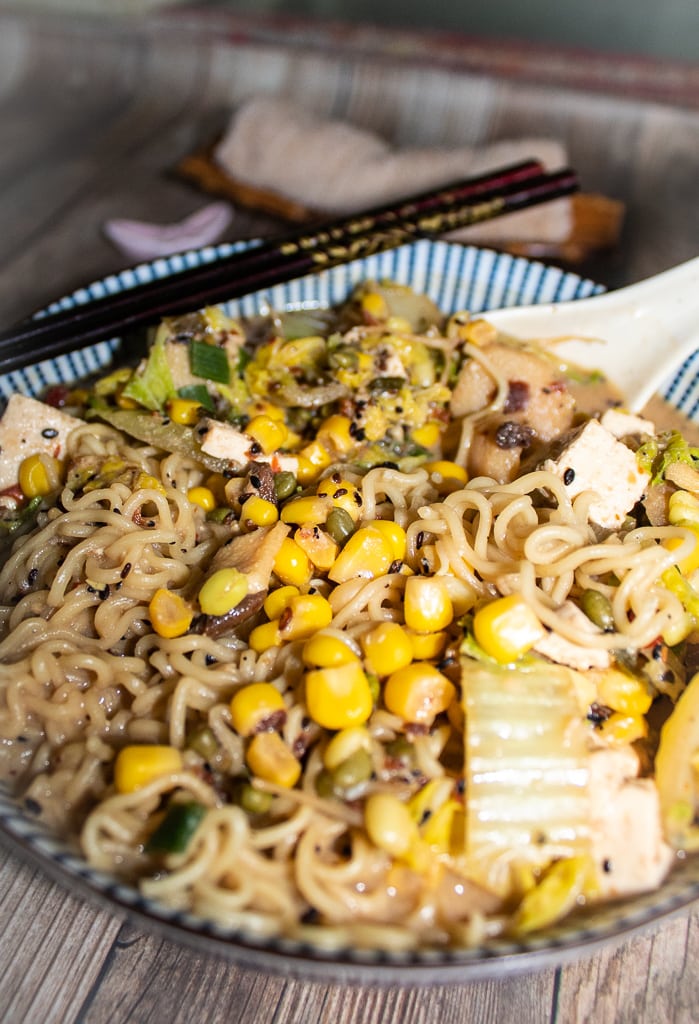
More Asian-Inspired Vegan Recipes
For those of you new to the whole food plant-based lifestyle, we’ve created a FREE 7-Day Plant-Based Menu Planner to help you get started!
If you try this recipe, please let us know how you like it by rating it and leaving a comment. We love to hear from you!
Want to Save This Recipe?
Enter your email & I’ll send it to your inbox. Plus, get great new recipes from me every week!
By submitting this form, you consent to receive emails from EatPlant-Based
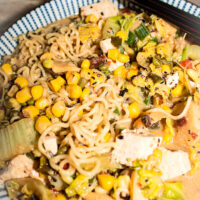
Vegan Miso Ramen Japanese Soup
Ingredients
Soup Base
- 2 cups vegetable broth or dashi broth recipe linked
- 2 teaspoons garlic minced
- 1/2 teaspoon ginger minced
- 1 cup green onions chopped into thin rounds
- 1 tablespoon Doubanjiang spicy bean paste
- 1 tablespoon pure cane sugar or other sweetener
- 3 tablespoons red miso
- 1 tablespoon sake
- 1/2 teaspoon salt
- 2 teaspoons sesame seeds toasted and ground (white/black seeds)
- 1 tablespoon soy sauce low sodium
- 2 cups soy milk
Topping Options
- 6 oz firm tofu 1/2 pkg, drained, pressed, and cut into cubes
- 3 cups napa cabbage sliced into thin strips
- 1 cup bean sprouts
- 1/2 cup baby corn or 1/2 cup sweet kernel corn
- 1/2 cup bamboo slices
- 1/2 cup sliced water chestnuts
- 1 sheet nori seaweed cut into strips
- 1 pinch white pepper powder
- 2 bundles 6 oz Japanese ramen noodles, cooked and drained
Instructions
Prep Work
- This is not a difficult soup to make, so don’t be intimidated by the length of the instructions. We’re just trying to be thorough so you’ll be sure to have an awesome soup outcome.
- To begin, you will need to wash, drain, and slice all of the vegetables so they will be ready to add as soon as the soup base is ready. I have included detailed notes and photos that will be very helpful above.
- Toast the sesame seeds by placing them in a dry frying pan and heating them on medium-high heat for just a few minutes. They will begin to turn a golden brown and start popping up out of the pan. Do not leave the pan unattended because it will burn quickly. Once the seeds are lightly browned, remove them from the heat and pour them into a small bowl, and set them to the side.
- You will also want to set out everything needed for the ramen noodles as well (but don’t cook them yet). This will include having a stockpot filled with water and heating on the stovetop, a package of noodles, and 1 tablespoon of baking soda. Even though cooking the noodles is the last step of this soup, I keep my stockpot with the water and baking soda in it ready and heating on the stove while I work on my soup base so that I can get the noodles started easily.
Soup Base
- I prepare my soup base ingredients first and have them ready to whisk in. Since this is a little like making gravy, it’s best to be able to move through quickly so that it doesn’t scorch to the bottom of the pan.
- Use a 3-quart soup pot and heat about ¼ cup of the veggie broth in the bottom of the pan over medium-high heat. Mix your garlic, ginger, and half of the green onions into the dashi and cook for 1-2 minutes until fragrant.
- Next, add the Doubanjiang bean paste, sugar, and miso stirring regularly with a whisk or wooden spoon to keep the mixture from sticking to the bottom of the pan. You can add more dashi if you need to keep the mixture creamy.
- Add the sake (the alcohol cooks out), salt, sesame seeds, and soy sauce and whisk together until the mixture is smooth.
- Begin adding soy milk, whisking it and gradually dissolving the other ingredients.
- Slowly add the rest of the dashi broth into the mixture, continuing to blend into a creamy soup base.
- Once it is piping hot and smooth, it’s time to start adding the toppings–veggies, tofu, and nori. Add the napa cabbage first and let it simmer for 1-2 minutes before adding the other toppings.
- Add in the other toppings and let them simmer together for approximately 1-2 minutes, or until your veggies are the desired texture.
- Remove the soup from the heat while finishing up the noodles.
Cooking the Noodles
- Ramen noodles cook quickly, usually within a couple of minutes, so make sure everything else is prepared and ready to go. This is your last step, once the noodles are drained, you’ll add them to the soup base with the various toppings you’ve prepared and serve the piping hot ramen immediately.
- Cook noodles according to your package instructions (usually 1 ½ to 2 minutes). Adding baking soda to ramen noodles while they are boiling gives them more of the authentic chewy texture you get in Japan. Just add the baking soda to the boiling water then add the ramen noodles.
- Uncover the pot, watch carefully, and be prepared to blow it will boil over.
- Drain noodles as soon as they are done so that they don’t absorb excess moisture and become mushy. There is no need to rinse them.
- Immediately divide noodles into bowls and add soup and toppings.
Video
Notes
- Ingredients- Visit your local Asian grocer or Amazon to find these ingredients. There is an initial upfront investment if you’re not accustomed to cooking with Asian ingredients, but we’re working to give you a variety of tasty recipes to use these same ingredients in and they store well.
- Doubanjiang bean sauce- You can use the mild version if you are concerned it may be too spicy or reduce the amount used to one teaspoon. This paste/sauce can be found in Asian grocery stores and online.
- Toppings- Adjust your choice of soup garnishments and portions to your personal preferences. Cutting ingredients into long thin pieces aids with eating if you’re using chopsticks.
- Canned veggies- For the canned sliced chestnuts, bamboo, kernel, and baby corn, I like to mix them together after draining and then freeze what I don’t use in small portions for future ramen bowls. They are also great for use in stir-fries.
- Noodles- We don’t easily find fresh ramen noodles where we live, on the east coast, but most Asian grocers carry them in frozen and dried aisles. They are also available online and there are gluten-free options available. When I can’t get fresh noodles, I prefer the frozen variety because they have a nice chewy texture. The frozen brands do tend to be a little more expensive than the dried ones. I always keep dried noodles on hand because they store so well and using the baking soda trick makes them a great compromise.
- Storage- Soup base stores well in the fridge for up to three days. Just reheat and add the toppings when you are ready to eat!
- Proper eating- Slurping noodles and soup is not considered bad manners in Japan so, when eating Japanese fare, be authentic. Turn that bowl up and drink! You can also use a soup spoon with your chopsticks.
Nutrition
Disclaimer
To obtain the most accurate representation of the nutritional information in a given recipe, you should calculate the nutritional information with the actual ingredients used in your recipe, using your preferred nutrition calculator. You are solely responsible for ensuring that any nutritional information provided is accurate, complete, and useful.
About the Chef
Drenda-Michell Brennan lived in Japan in the 1980s and 90s where she enjoyed spending much of her time visiting the kitchens of family and friends, watching and learning to prepare traditional Japanese cuisine. She is the mother of three Japanese-American grown children and grandmother (HuneyGram) to nine grandchildren. Read More…

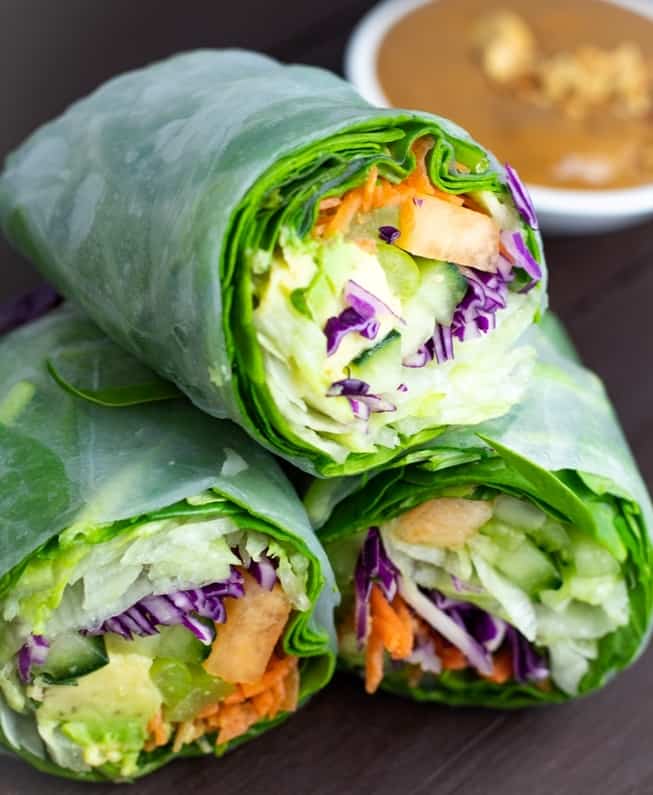


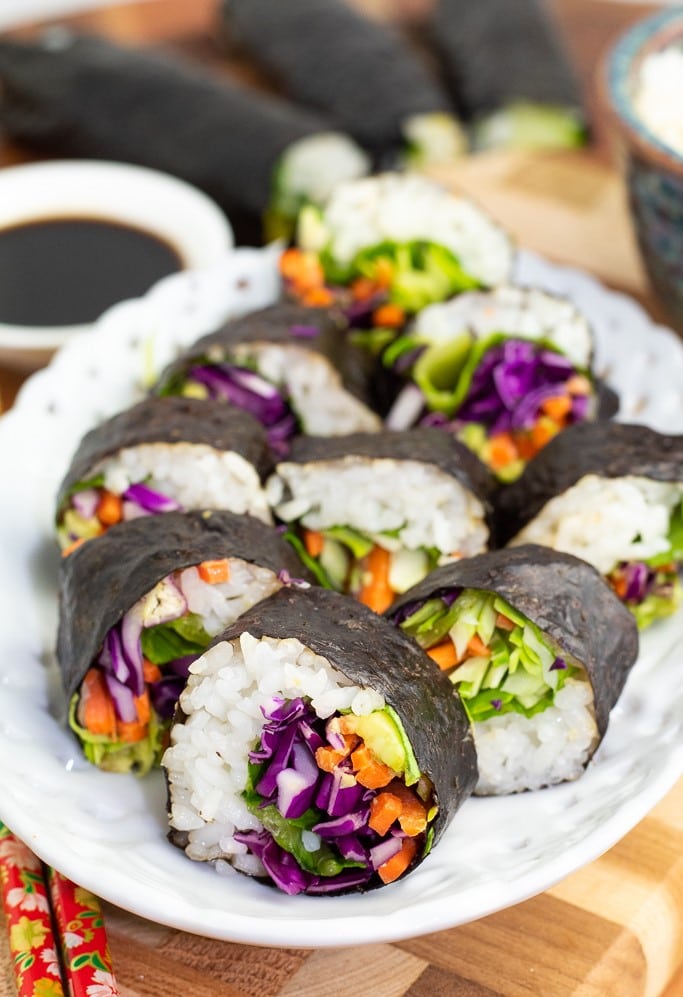

This is delicious broth! Full of umami.
Hi Lisa- I’m so glad that you liked it!